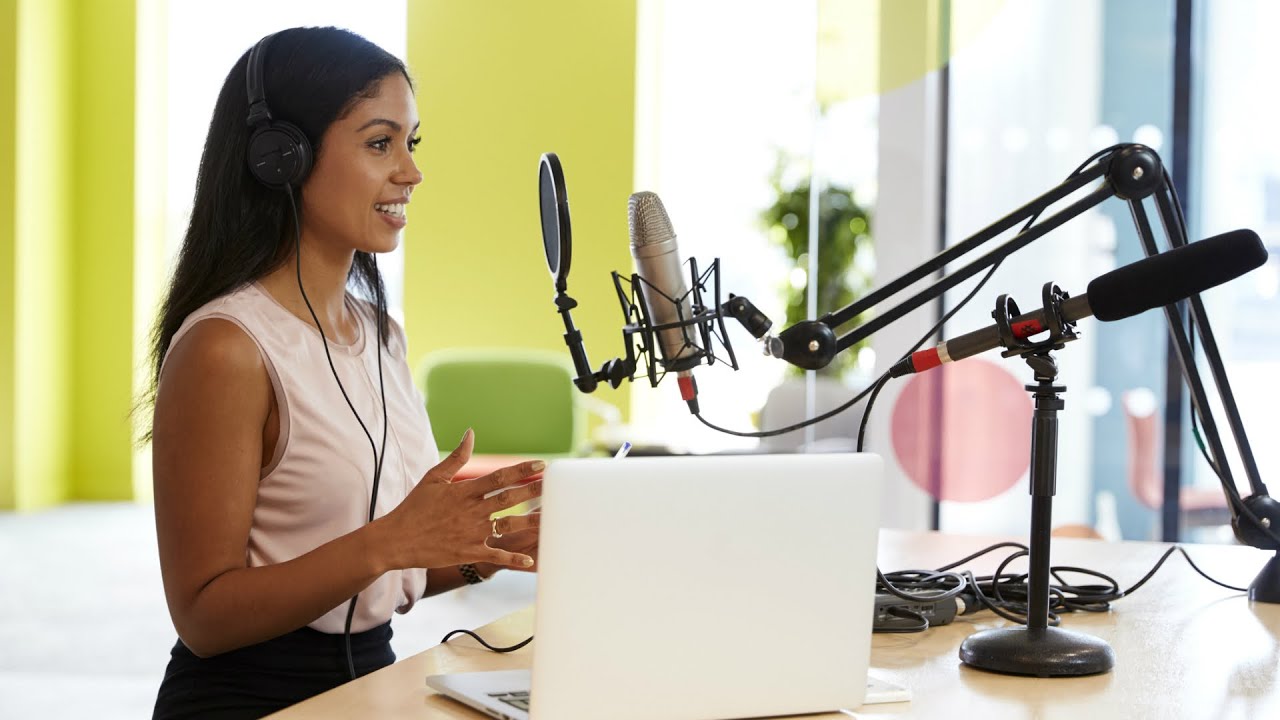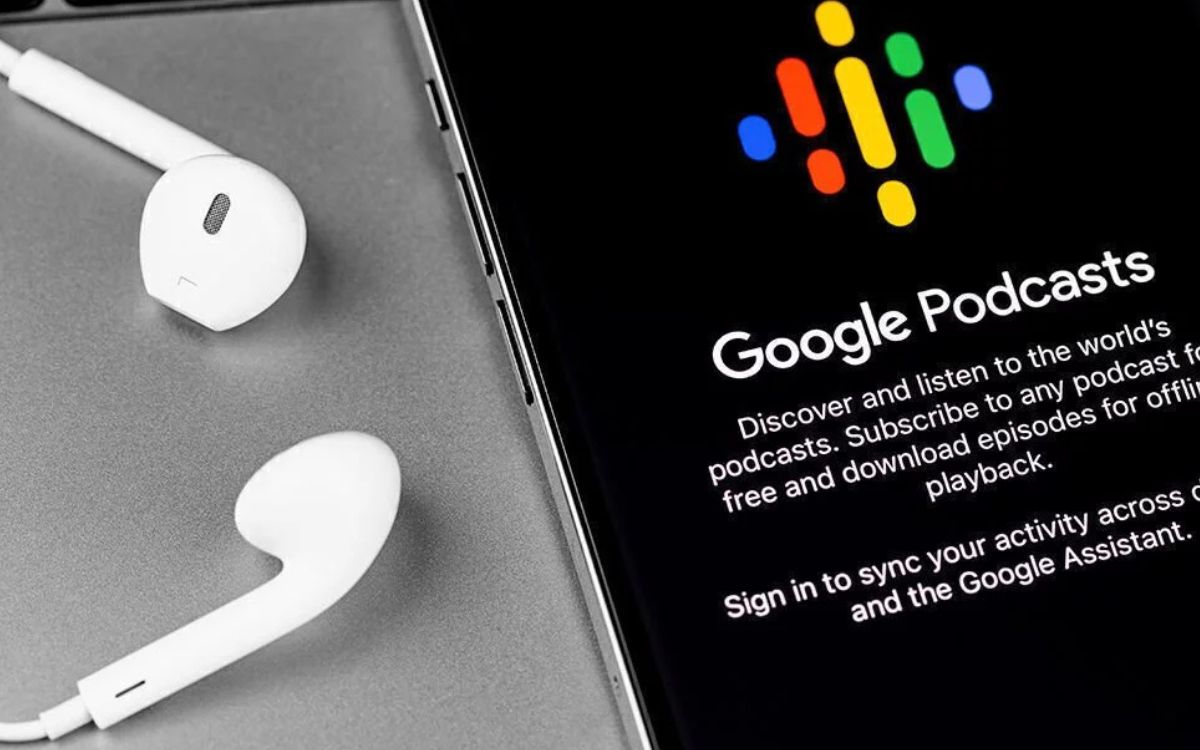Home>Events & Info>Podcast>Why Podcast


Podcast
Why Podcast
Modified: January 22, 2024
Discover the power of podcasts and unlock a world of knowledge and entertainment. Dive into the fascinating world of podcasting and explore a variety of topics with our curated collection.
(Many of the links in this article redirect to a specific reviewed product. Your purchase of these products through affiliate links helps to generate commission for AudioLover.com, at no extra cost. Learn more)
Table of Contents
- Introduction
- Understanding Podcasting
- Benefits of Podcasting
- Expanding Audience Reach
- Building Brand Authority
- Creating Engaging Content
- Monetizing Your Podcast
- Getting Started with Podcasting
- Choosing the Right Equipment
- Setting Up Recording Software
- Planning and Scripting Your Episodes
- Recording and Editing Your Podcast
- Creating Eye-Catching Cover Art
- Hosting and Publishing Your Podcast
- Promoting Your Podcast
- Engaging with Your Audience
- Measuring Success
- Conclusion
Introduction
Podcasting has become an incredibly popular form of media, allowing individuals to share their knowledge and stories in a convenient and accessible format. With the rise of smartphones and audio streaming platforms, podcasts have gained a dedicated and loyal following, making it a powerful tool for content creators, businesses, and individuals alike.
But what exactly is podcasting? In simple terms, a podcast is a digital audio or video file that can be downloaded or streamed online. It typically consists of a series of episodes that are released periodically, covering a wide range of topics such as interviews, storytelling, educational content, and much more.
The beauty of podcasting lies in its versatility. Whether you are a seasoned expert in a particular field or someone with a passion for exploring different topics, podcasting offers a unique platform to connect with an audience on a personal level. Unlike other forms of media, podcasts allow for a more intimate and immersive experience, as listeners have the freedom to tune in at their convenience and engage with the content in a more meaningful way.
Podcasting offers numerous benefits, whether you are an individual looking to share your knowledge and experiences or a business aiming to reach a wider audience and establish your brand authority. In the sections that follow, we will explore some of the key advantages of podcasting and provide you with practical tips on how to create and optimize your podcast for success.
Understanding Podcasting
Before delving into the world of podcasting, it’s important to have a solid understanding of its key components and how it works. Podcasting involves a few essential elements:
- Episodes: Podcasts are comprised of episodes, which are individual segments of content. These episodes can be centered around specific themes, topics, or interviews.
- RSS Feed: An RSS (Really Simple Syndication) feed is essential for distributing your podcast. It acts as a channel through which your episodes are delivered to podcast directories and platforms.
- Podcast Directories: These directories are platforms (such as Apple Podcasts, Spotify, and Google Podcasts) where users can search for and discover podcasts. Submitting your podcast to these directories helps expand your reach and increase visibility.
- Podcast Players: Podcast players or apps allow listeners to stream or download episodes. These players provide a user-friendly interface that makes it easy for listeners to subscribe, receive automatic episode updates, and listen on-the-go.
Podcasting is unique in that it provides a passive form of content consumption. Listeners have the freedom to tune in whenever and wherever they choose, making it a versatile and convenient medium. Additionally, the audio format allows for multitasking, allowing listeners to engage with the content while commuting, exercising, or doing other activities.
Podcasts cover a vast array of topics, catering to diverse interests. From true crime and storytelling to business advice, health tips, and even fictional narratives, there is a podcast out there for everyone. This variety of content ensures that podcasting has a wide and dedicated audience base.
Podcasting is not limited to just audio. Many podcasts also incorporate video elements, known as vodcasts or video podcasts. These video podcasts offer the benefits of both visual and audio engagement, providing a richer experience for the audience.
Now that you have a basic understanding of what podcasting is and how it functions, let’s explore the numerous benefits it offers for individuals and businesses in the next sections.
Benefits of Podcasting
Podcasting offers a host of benefits for content creators, businesses, and individuals looking to share their knowledge, stories, and experiences. Here are some of the key advantages of podcasting:
- Expanding Audience Reach: Podcasting allows you to reach a global audience. With podcast directories and platforms readily available, your content can be discovered by people from all walks of life. The convenience of on-demand listening means that your episodes can be consumed at any time, creating opportunities for engagement with listeners across different time zones.
- Building Brand Authority: Consistently sharing valuable and insightful content through podcasting helps establish you as an authority in your niche or industry. By bringing in guests or sharing your expertise, you can position yourself as a trusted source of information and increase your credibility.
- Creating Engaging Content: Podcasting allows for a more intimate and personal connection with your audience compared to other forms of media. By leveraging the power of storytelling and conversational style, you can captivate listeners and keep them coming back for more. The audio format also enables you to convey emotions, tone, and inflections, making your content more engaging and relatable.
- Monetizing Your Podcast: Podcasting provides various opportunities for monetization. You can integrate advertisements or sponsorships into your episodes, collaborate with brands for sponsored content, offer exclusive bonus episodes or content to your subscribers, or even create premium subscriptions for access to special features or interviews.
In addition to these benefits, podcasting also allows for networking opportunities, collaboration with industry experts, fostering a loyal and engaged community, and boosting your visibility in search engine results. The accessibility and portability of podcasts make them an excellent medium for connecting with listeners on a deeper level.
Now that we’ve explored the advantages of podcasting, let’s dive into the practical aspects of getting started with podcasting in the next sections.
Expanding Audience Reach
One of the most significant benefits of podcasting is its ability to reach a wide audience. With the increasing popularity of podcasts, more and more people are turning to this medium for entertainment, education, and information. Here are some strategies to help you expand your podcast’s audience reach:
- Optimize Your Podcast for Search: Just like websites, podcasts can be optimized for search engines. Be sure to include relevant keywords in your podcast titles, descriptions, and episode titles. This will help your podcast appear in search results when users are looking for specific topics.
- Promote Your Podcast on Social Media: Leverage the power of social media platforms to promote your podcast. Create engaging posts that highlight your latest episodes, share behind-the-scenes insights, and encourage listeners to subscribe and share with their networks.
- Guest on Other Podcasts: Collaborating with other podcasters in your niche can help you tap into their established audience base. Seek opportunities to be a guest on relevant podcasts, where you can share your expertise and introduce yourself to a new audience.
- Utilize Podcast Directories: Submit your podcast to popular podcast directories such as Apple Podcasts, Spotify, Google Podcasts, and Stitcher. This will make it easier for listeners to discover and subscribe to your podcast.
- Encourage Reviews and Ratings: Reviews and ratings play a crucial role in attracting new listeners. Encourage your audience to leave reviews and ratings on podcast platforms, as positive feedback can often sway potential listeners to give your podcast a try.
- Create Shareable Content: Develop snippets or highlight reels that can be easily shared on social media. These bite-sized content pieces can pique the interest of potential listeners and encourage them to check out your full episodes.
Remember to engage with your audience regularly by responding to comments, messages, and reviews. Building strong relationships with your listeners can lead to loyal fans who will help spread the word about your podcast.
Expanding your audience reach takes time and dedication. Stay consistent with your podcast schedule, deliver high-quality content, and actively promote your podcast across multiple channels. With a proactive approach, you can grow your listener base and reach a wider audience.
Now that we’ve covered expanding audience reach, let’s explore the next benefit of podcasting: building brand authority.
Building Brand Authority
Podcasting is a powerful tool for building brand authority and establishing yourself as an expert in your industry or niche. By consistently delivering valuable and insightful content, you can position yourself and your brand as a trusted source of information and expertise. Here’s how podcasting can help you build brand authority:
- Showcasing Expertise: As a podcast host, you have the opportunity to showcase your expertise and knowledge on specific topics. By sharing valuable insights, tips, and experiences, you can demonstrate your proficiency and authenticity, ultimately boosting your credibility and building trust with your audience.
- Interviewing Industry Experts: Inviting industry experts as guests on your podcast not only provides your audience with valuable insights but also enhances your own brand authority. By associating yourself with respected and knowledgeable individuals, you position yourself as a trusted authority within your niche.
- Establishing Thought Leadership: Thought leadership is about being at the forefront of your industry and driving conversations and innovations. Through podcasting, you can express your unique viewpoints, share industry trends and predictions, and contribute to the ongoing discussions within your field. This helps solidify your brand as a thought leader and someone who is actively engaged with the industry.
- Consistency and Expertise: Consistently delivering high-quality podcast episodes that provide value to your audience helps build your brand authority over time. By demonstrating your expertise and dedication to your craft through consistent content creation, you establish yourself as a reliable and credible source.
Building brand authority through podcasting requires a thoughtful approach and a focus on delivering content that is valuable and relevant to your target audience. Here are some tips to enhance your brand authority:
- Research and Preparation: Conduct thorough research on your topics to ensure that the information you provide is accurate and up-to-date. Preparation is essential for presenting yourself as a knowledgeable expert.
- Engage with Your Audience: Actively engage with your listeners by responding to comments and messages. This helps foster a sense of community and reinforces your brand’s authority by demonstrating that you care about your audience’s questions and feedback.
- Be Authentic: Authenticity is key to building trust and credibility. Be your genuine self on your podcast, sharing personal anecdotes and experiences that resonate with your audience. This human touch will help you connect with your listeners on a deeper level.
Building brand authority is a long-term endeavor that requires consistency, quality content, and authentic engagement with your audience. By positioning yourself as an authority in your niche through podcasting, you can create a strong brand identity and attract loyal followers and customers.
Next, let’s discover the importance of creating engaging content for your podcast.
Creating Engaging Content
Creating engaging content is vital for capturing and retaining your audience’s attention in the competitive podcasting landscape. Your goal is to create episodes that not only provide valuable information but also entertain, inspire, and connect with your listeners on a personal level. Here are some tips to help you create engaging content for your podcast:
- Define Your Target Audience: Understanding your target audience is crucial for tailoring your content to their interests and needs. Research their preferences, pain points, and the topics they are most interested in. This will help you craft episodes that resonate with them and keep them coming back for more.
- Storytelling: Humans are wired to respond to stories, so incorporating storytelling techniques into your podcast can captivate your audience. Share personal anecdotes, case studies, or real-life examples that illustrate your points and make your content relatable and engaging.
- Varied Episode Formats: Change up your episode formats to keep your content fresh and exciting. Consider incorporating interviews, solo episodes, roundtable discussions, and even audience Q&A sessions. This variety will cater to different listening preferences and add diversity to your podcast.
- Keep it Conversational: Adopt a conversational tone when delivering your content. Imagine you are having a dialogue with a friend rather than delivering a formal presentation. This will make your podcast feel more relaxed and relatable, fostering a deeper connection with your audience.
- Interactive Elements: Find ways to actively engage your audience during your episodes. This can include posing questions, encouraging listener participation through social media, or hosting contests and giveaways. Interactive elements make your podcast more interactive and create a sense of community around your content.
- Guest Contributors: Inviting guests who bring unique perspectives and insights into your episodes can add variety and freshness to your content. They can provide a different voice and expertise, making your podcast more engaging and diverse.
Additionally, pay attention to the production quality of your podcast. Clear audio, good editing, and well-paced episodes enhance the overall listening experience and keep your audience engaged. Consider using intro/outro music, sound effects, and transitions to add a professional touch to your podcast.
Remember, consistent and regular episodes are vital for building and retaining your audience. Establish a schedule that works for you and stick to it. This predictability will create anticipation and loyalty among your listeners.
By focusing on creating engaging content that educates, entertains, and connects with your audience, you will build a loyal following and differentiate yourself in the competitive podcasting space.
Next, let’s explore the various ways to monetize your podcast.
Monetizing Your Podcast
Podcasting has become a popular platform for generating income and monetizing your passion. While it may take time and effort to build a substantial audience and attract advertisers or sponsors, there are several monetization strategies you can implement. Here are some ways to monetize your podcast:
- Advertising and Sponsorships: One of the most common methods of monetizing a podcast is through advertisements and sponsorships. You can partner with companies in your niche and promote their products or services on your podcast. This can be done through dynamic ad inserts or by delivering a personal endorsement during your episodes.
- Affiliate Marketing: Affiliate marketing involves promoting products or services and receiving a commission for every sale made through your unique affiliate link. You can partner with relevant brands and recommend their products or services to your audience. Whenever a listener makes a purchase using your affiliate link, you earn a commission.
- Premium Content or Memberships: Another way to monetize your podcast is by offering premium content or creating a membership program. This can include bonus episodes, exclusive interviews, access to a private community, or early access to episodes. You can charge a subscription fee or offer tiered membership options.
- Product or Service Promotion: If you have your own products or services that align with your podcast’s niche, you can promote them to your audience. This can include online courses, books, consulting services, or merchandise related to your podcast.
- Crowdfunding: Crowdfunding platforms like Patreon or Kickstarter allow fans and listeners to support your podcast financially. You can offer exclusive perks and rewards to your patrons in exchange for their support, such as bonus episodes, Q&A sessions, or behind-the-scenes access.
- Live Events and Workshops: If you have a strong and engaged audience, you can organize live events or workshops related to your podcast’s topic. This can include hosting a live recording of your podcast, organizing workshops or conferences, or even offering one-on-one coaching sessions.
When considering monetization strategies, it’s essential to strike a balance between generating income and maintaining the trust of your audience. Be transparent about any sponsored content or affiliate partnerships. Your listeners value your authenticity, so ensure that the products or services you promote align with your podcast’s values and provide genuine value to your audience.
Remember, monetizing your podcast may not happen overnight. It takes time to build a loyal audience and attract advertisers or sponsors. Focus on consistently delivering high-quality content, engaging with your listeners, and growing your podcast’s reach. Over time, as your influence and audience grow, monetization opportunities will become more accessible.
Now that we’ve explored various monetization strategies for your podcast, let’s move on to getting started with podcasting.
Getting Started with Podcasting
If you’re ready to jump into the exciting world of podcasting, here are some essential steps to help you get started:
- Choose the Right Equipment: Invest in quality podcasting equipment. This typically includes a microphone, headphones, and a pop filter to improve audio quality and minimize background noise. Consider your budget and research different options to find the best fit for your needs.
- Set Up Recording Software: Select recording software that suits your requirements. Popular options include Audacity (free and open-source), Adobe Audition, GarageBand (for Mac users), or Reaper. Familiarize yourself with the software and its features to ensure smooth recording and editing.
- Plan and Script Your Episodes: Outline your podcast episodes by planning a structure and creating a script or talking points. This helps ensure a smooth flow and cohesive content, keeping your listeners engaged. Prepare questions, intros, and outros to make the recording process easier.
- Record and Edit Your Podcast: Find a quiet location to record your podcast episodes. Use your microphone and recording software to capture your voice and any additional audio elements. Once recorded, edit your episodes by eliminating any mistakes, adjusting audio levels, and adding music or sound effects to enhance the listening experience.
- Create Eye-Catching Cover Art: Design visually appealing cover art that represents your podcast. This is the first impression potential listeners will have, so make sure it reflects your podcast’s theme and captures attention. Use design tools like Canva or hire a graphic designer to help create professional and eye-catching cover art.
- Host and Publish Your Podcast: Choose a podcast hosting platform to store and distribute your episodes. These platforms provide an RSS feed that podcast directories use to display your podcast. Popular hosting platforms include Libsyn, Podbean, and Buzzsprout. Once you’ve uploaded your episodes to your hosting platform, submit your podcast to directories like Apple Podcasts, Spotify, and Google Podcasts.
- Promote Your Podcast: Develop a promotional strategy to increase the visibility of your podcast. Leverage social media platforms to share updates, episode releases, and engage with your audience. Collaborate with other podcasters, write guest blog posts, and seek opportunities to be featured on other podcasts to expand your reach.
Remember, podcasting is a journey, and it takes time to develop an audience and refine your skills. Be consistent in your releases and continuously seek ways to improve your content and engage with your listeners.
As you gain experience and grow your podcast, you can explore advanced techniques such as guest interviews, listener feedback, and incorporating listener questions. These elements add variety and interaction, enhancing the overall podcasting experience.
Celebrate your achievements along the way, stay true to your passion, and enjoy the process of creating meaningful and engaging content through podcasting.
Now that you have the fundamentals to start your podcasting journey, it’s time to pick up the microphone and bring your unique voice to the world!
Choosing the Right Equipment
Choosing the right equipment is crucial for producing high-quality audio and ensuring an optimal podcasting experience. Here are the key considerations when selecting podcasting equipment:
- Microphone: Invest in a quality microphone to capture clear and professional-sounding audio. USB microphones, such as the Blue Yeti or Audio-Technica ATR2100x, are popular options for beginners due to their ease of use and affordability. XLR microphones, like the Shure SM58 or Rode PodMic, provide higher audio quality but require an audio interface to connect to your computer.
- Headphones: Choose a comfortable and closed-back pair of headphones to monitor your audio while recording and editing. Closed-back headphones, like the Audio-Technica ATH-M50x or Sony MDR7506, offer noise isolation and prevent sound leakage during recording.
- Pop Filter: A pop filter is a screen placed in front of the microphone to reduce plosive sounds, such as “p” and “b” sounds, that can distort the audio. It helps ensure clearer recordings and eliminates the need for extensive post-production editing.
- Boom Arm or Mic Stand: Consider using a boom arm or mic stand to hold your microphone. It helps position the microphone at the appropriate distance and angle for optimal audio capture. Boom arms, like the Heil Sound PL-2T or Rode PSA1, can be easily adjusted and provide flexibility during recordings.
- Acoustic Treatment: If possible, create a dedicated recording space or use acoustic treatment materials to minimize echo and unwanted background noise. Foam panels, bass traps, and diffusers can enhance the overall sound quality by reducing reverberations and creating a more controlled recording environment.
- Additional Accessories: Depending on your setup, you may also need an audio interface to connect XLR microphones to your computer, a shock mount to isolate the microphone from handling noise, and a pop shield, which is a foam cover that further reduces plosive sounds.
When choosing equipment, take into account your budget, recording environment, and long-term goals. Research different brands, read reviews, and consider seeking recommendations from other podcasters to make an informed decision. It’s also worth exploring package deals or bundles that include multiple pieces of equipment for a discounted price.
Remember that while equipment is important, it’s equally crucial to focus on your content and delivery. Even with top-notch equipment, the substance of your podcast and your ability to engage and connect with your audience ultimately determines your success.
Finally, familiarize yourself with the technical aspects of setting up and configuring your equipment. Experiment with microphone positioning, test different recording and editing software options, and adjust audio levels to achieve the best sound quality possible.
Once you have your equipment setup, you can move on to setting up recording software and planning your podcast episodes.
Setting Up Recording Software
Recording software is essential for capturing and editing your podcast episodes. It allows you to control audio settings, edit out mistakes, and enhance the overall quality of your recordings. Here are the steps to set up and configure recording software for your podcast:
- Choose the Right Recording Software: There are numerous recording software options available, suited for different operating systems and levels of expertise. Audacity is a popular free and open-source software that works on both Windows and Mac. Adobe Audition and GarageBand (for Mac users) are more advanced options with additional features.
- Install and Set Up the Software: Download and install the recording software onto your computer. Follow the installation instructions provided by the software’s official website or documentation. Once installed, launch the software and familiarize yourself with its interface.
- Configure Audio Input and Output Settings: In the recording software, access the preferences or settings menu to configure your audio input and output devices. Select your microphone as the input device to ensure that your recordings capture audio from the correct source. Set your headphones or speakers as the output device to monitor the audio playback.
- Adjust Recording Levels: Check the recording levels in your software to ensure that your microphone is properly capturing audio without distortion. Aim to have the audio levels peak around -12 dB to -6 dB to leave enough headroom. Experiment with the input gain settings on your microphone or adjust the software’s input volume slider to achieve the desired recording levels.
- Test and Calibrate: Before recording your podcast episodes, conduct test recordings to ensure that your audio quality is optimal. Listen for any background noise, echoes, or distortion. Adjust the positioning of your microphone and make any necessary changes in the software’s settings to achieve the best audio quality.
- Explore Additional Features: Familiarize yourself with the different features and tools offered by the recording software. These may include noise reduction, equalization, compression, and audio effects. Experiment with these options to improve the overall sound quality of your recordings.
Take the time to understand your chosen recording software and explore tutorials or online resources that can help you navigate its features effectively. Each software has its own learning curve, but with practice, you’ll become more comfortable and proficient in using it to produce high-quality podcast episodes.
Remember to save your recordings in a compatible file format, such as WAV or MP3, for easy editing and sharing. Keep track of your recording settings and preferences to maintain consistency throughout your podcasting journey.
With your recording software properly set up, you’re now ready to plan and script your podcast episodes. This crucial step ensures that your content flows smoothly and keeps your audience engaged. We’ll explore this topic further in the upcoming section.
Planning and Scripting Your Episodes
Planning and scripting your podcast episodes is a key step in creating organized and engaging content. It helps ensure that your ideas are structured, your message is clear, and you deliver a cohesive podcast experience for your audience. Here are some tips for effective planning and scripting:
- Define Your Podcast’s Topic and Format: Determine the focus and format of your podcast. Is it an interview-style show, a solo talk, or a mix of both? Decide on a specific topic or theme for each episode to provide clarity and maintain a consistent flow.
- Create an Outline: Develop an outline that outlines the main points and flow of your episode. Break it down into segments or sections that cover different aspects of your topic. This will act as a roadmap for your episode and ensure you cover all the essential elements.
- Research and Gather Information: Conduct research on your chosen topic to gather relevant and up-to-date information. Stay informed about the latest trends, news, or studies that relate to your subject matter. This will help you provide valuable insights and keep your content fresh.
- Prepare Questions or Talking Points: Depending on your podcast format, prepare a list of questions or talking points to guide your discussions. This ensures that you cover all the relevant aspects and prompts engaging conversations, whether you’re interviewing a guest or discussing the topic on your own.
- Balance Structure and Spontaneity: While it’s essential to have a well-structured episode, allow room for spontaneity and organic conversation. Avoid speaking strictly from a script. Instead, use your outline and prepared questions as a guide to spark discussions and maintain a natural flow.
- Infuse Storytelling and Examples: Storytelling is a powerful tool to captivate your listeners. Include anecdotes, real-life examples, or case studies to illustrate your points and provide relatable content. Stories create a connection with your audience and make your episodes more engaging.
- Consider Episode Length: Determine the ideal length for your episodes based on your target audience, topic, and format. Keep in mind that attention spans vary, so try to deliver the most value within a reasonable timeframe. Aim for episodes that are long enough to delve into the topic but not so long that they lose listener interest.
While scripting your episodes is important, remember to maintain authenticity and let your personality shine through. Avoid sounding overly rehearsed or reading your script word for word. Instead, use bullet points or key phrases as prompts to fuel spontaneous and natural conversations.
Once you have your episode planned and scripted, take the time to rehearse and familiarize yourself with the content. This will help you deliver a more confident and polished performance during recording.
With your episodes well-planned and scripted, you’re ready to move on to the next crucial step in podcasting: recording and editing. We’ll explore this topic further in the upcoming section.
Recording and Editing Your Podcast
Recording and editing are critical steps in producing a professional and polished podcast. With proper recording techniques and effective editing, you can deliver high-quality audio and create a seamless listening experience for your audience. Here’s a step-by-step guide to help you through the process:
Recording:
- Create a Quiet Recording Environment: Find a quiet space with minimal background noise to ensure clean audio recordings. Consider using acoustic treatment materials to minimize echo and reverberations.
- Set Up Your Equipment and Software: Connect your microphone, headphones, and other necessary equipment. Open your recording software and ensure that the correct input and output devices are selected.
- Check Audio Levels: Set your microphone at an appropriate distance and adjust the recording levels to avoid distortion. Monitor the audio levels during recording to ensure optimal sound quality.
- Record Room Tone: Capture a few seconds of room tone at the beginning of your recording. This allows for easier noise removal during the editing process.
- Follow Your Script or Talking Points: Refer to your prepared script or talking points and maintain a conversational and authentic tone. Speak clearly, adjust your pacing, and emphasize key points to engage your audience.
- Minimize Mistakes: Try to record your segments as smoothly as possible. If you make a mistake while speaking, pause momentarily and restart from a point where editing will be easier.
Editing:
- Trim and Remove Unwanted Sections: In your editing software, trim any unnecessary pauses, mistakes, or background noises. Remove any segments that do not contribute to the overall flow of the episode.
- Enhance Audio Quality: Use audio editing tools to adjust the volume levels, equalize the audio, and eliminate any remaining background noise. Apply compression to make the audio levels consistent throughout the episode.
- Add Intro and Outro Music: Incorporate intro and outro music to give your podcast a professional touch. Ensure that the music aligns with the tone of your podcast and doesn’t overpower the dialogue.
- Insert Transitions: Smooth out the flow of your episode by adding transitions between segments or different parts of the conversation. Transitions can be as simple as fading in and out or using sound effects.
- Include Additional Elements: If desired, insert sound effects, excerpts from interviews, or listener feedback to enhance the overall listening experience and engage your audience further.
- Normalize and Export: Normalize the audio levels to ensure a consistent listening experience. Once you’re satisfied with the editing, export the episode in a suitable file format, such as WAV or MP3, with an appropriate bitrate.
While editing your episodes, keep in mind that less is often more. Don’t over-edit or remove all natural pauses and breaths, as those elements can add authenticity and a human touch to your podcast.
Finally, be sure to listen to the final edited version of your episode before publishing. This will ensure that everything sounds clean, clear, and well-balanced.
With your episode recorded and edited, it’s time to focus on creating appealing cover art that will attract potential listeners. We’ll explore this topic in the next section.
Creating Eye-Catching Cover Art
Eye-catching cover art is essential to attract potential listeners and make your podcast stand out in a saturated market. Your podcast cover art is the first visual impression people have of your show, so it’s crucial to create a design that captures attention and represents your podcast’s theme and brand. Here are some tips to help you create eye-catching cover art for your podcast:
- Choose a Clear, Legible Title: Make sure your podcast title is clear and easy to read. Select a font style that is visually appealing and matches the tone and theme of your podcast. Use contrasting colors to enhance readability.
- Incorporate Relevant Imagery: Select imagery that relates to your podcast’s topic or genre. This can be a photograph, an illustration, or a combination of both. Ensure the imagery is well-composed, visually appealing, and relevant to your content. Consider incorporating your podcast’s logo or branding elements as well.
- Use Color Palettes That Grab Attention: Choose a color palette that resonates with your podcast’s theme and evokes the desired emotions. Bright, bold colors or contrasting color combinations can help your cover art grab attention amidst a sea of other podcast thumbnails.
- Create a Focal Point: Consider creating a focal point in your cover art to draw the viewer’s attention. It could be a central image, an intriguing element, or an interesting arrangement of text and imagery. Ensure the focal point aligns with your podcast’s message or the main theme you want to convey.
- Keep It Simple and Uncluttered: Avoid overcrowding your cover art with too many elements. Keep the design clean and uncluttered to ensure readability, especially when viewed in smaller sizes on podcast platforms. The key is to convey the essence of your podcast in a visually appealing and concise manner.
- Aim for Consistency: A consistent visual identity across your podcast episodes can help build recognition and establish a strong brand. Use a consistent color scheme, typography, and overall style that aligns with your podcast’s branding and theme.
- Consider Scalability: Ensure that your cover art looks great in different sizes and formats. Your design should be easily recognizable and legible even when viewed as a small thumbnail. Test your cover art designs at various sizes to ensure they maintain their visual impact.
If you’re not skilled in graphic design, there are various tools available that can help you create professional-looking cover art. Canva and Adobe Spark offer templates and user-friendly interfaces to create stunning designs, even with limited design experience. Alternatively, you can work with a graphic designer to bring your vision to life.
Remember to save your cover art in the appropriate file format, such as JPG or PNG, and ensure it meets the size requirements of different podcasting platforms. This way, your cover art will display correctly and attractively across various podcast directories.
With eye-catching and visually appealing cover art, you’ll increase the chances of capturing the attention of potential listeners and enticing them to explore your podcast further.
Now that you have eye-catching cover art ready, let’s move on to the next crucial step: hosting and publishing your podcast.
Hosting and Publishing Your Podcast
Hosting and publishing your podcast is the final step before your episodes become available for listeners around the world. To ensure a seamless and widespread distribution of your podcast, follow these steps:
- Choose a Podcast Hosting Platform: Select a podcast hosting platform that suits your needs. Popular options include Libsyn, Podbean, Buzzsprout, and Anchor. These platforms store your podcast files, generate an RSS feed, and provide analytics to track your podcast’s performance.
- Create an Account and Upload Episodes: Sign up for an account on your chosen hosting platform. Once registered, you can start uploading your podcast episodes, adding show notes, and assigning titles and descriptions to each episode. Depending on the platform, you may have restrictions on the amount of storage or the number of episodes you can upload with a free account.
- Generate an RSS Feed: Your podcast hosting platform will automatically generate an RSS feed for your podcast. This feed is a unique URL that acts as a delivery mechanism to podcast directories. It contains information about your podcast, such as the episode titles, descriptions, and file links.
- Submit your Podcast to Directories: Submit your podcast’s RSS feed to popular podcast directories such as Apple Podcasts, Spotify, Google Podcasts, and Stitcher. These directories make your podcast easily discoverable for listeners searching for content in their preferred platforms.
- Provide Show Information: When submitting your podcast to directories, provide relevant information such as your podcast title, description, category, cover art, and website URL. Double-check that all details are accurate and align with your branding.
- Verify and Optimize Listings: Once your podcast is submitted, it may take some time for directories to review and approve your listing. During this time, verify that your podcast appears correctly in each directory and make any necessary adjustments. Optimize your listings with relevant keywords to improve discoverability.
- Embed a Podcast Player on Your Website: If you have a website or blog, consider embedding a podcast player on your site. This allows visitors to listen to your podcast directly from your website, increasing engagement and providing another platform for listeners to find your content.
It’s important to note that hosting platforms may have different processes and features, so familiarize yourself with the specific steps and options available on your chosen platform. Regularly check your hosting platform’s analytics to gain insights into your audience, episode performance, and geographic reach.
Remember, consistency is key. Keep your hosting platform updated with new episodes, show notes, and relevant information. This ensures that your podcast directory listings are up to date and accurate.
Now that your podcast is hosted and published, you can focus on promoting your podcast to expand your audience. We’ll explore effective strategies for podcast promotion in the next section.
Promoting Your Podcast
Promoting your podcast is essential to expand your listener base and increase the visibility of your show. To effectively promote your podcast and attract new listeners, consider implementing the following strategies:
- Utilize Social Media: Leverage the power of social media platforms to promote your podcast. Create engaging posts, share episode updates, behind-the-scenes insights, and exciting highlights. Engage with your audience, respond to comments, and encourage them to share your content with their networks.
- Create Engaging Visual Assets: Design visually appealing graphics and audiograms featuring snippets or highlights from your episodes. These assets can be shared on social media platforms and are highly shareable, piquing the interest of potential listeners and encouraging them to check out your podcast.
- Collaborate with Others: Seek collaborations with other podcasters, influencers, or experts in your niche. This can involve being a guest on their show or featuring them on yours. Cross-promotion exposes your podcast to new audiences and helps build valuable relationships within your industry.
- Write Guest Blog Posts: Contribute guest blog posts to popular blogs or publications that align with your podcast’s niche. Write informative and engaging content related to your podcast’s topic and include links to your podcast in the bio or within the article itself. This can drive traffic to your podcast and attract new listeners.
- Utilize Email Marketing: Build an email list of interested subscribers and regularly send newsletters or updates about your podcast. Include links to your latest episodes, upcoming guests, or special offers to encourage engagement and listenership.
- Participate in Podcast Directories and Communities: Join podcast directories, such as Reddit’s podcasting communities, and engage with like-minded individuals. Share insights, answer questions, and promote your podcast. These communities provide an opportunity to connect with fellow podcasters and potential listeners.
- Attend and Speak at Events: Look for relevant events, conferences, or industry gatherings where you can network and share your expertise. Participate in panel discussions, give presentations, or host live podcast recordings. This exposure helps position you as an authority in your niche while attracting new listeners.
- Ask for Reviews and Ratings: Encourage your listeners to leave reviews and ratings on podcast directories, such as Apple Podcasts. Positive reviews and high ratings improve your podcast’s visibility and credibility, making it more likely to be discovered by potential listeners.
Consistency and authenticity are crucial in all promotional efforts. Regularly release new episodes, engage with your audience, and authentically share your passion for your podcast’s topic. Building a strong community and fostering genuine connections with your listeners will lead to loyal fans who will support and help promote your podcast.
It’s important to note that podcast promotion takes time and effort. Be patient, persistent, and creative in your promotional strategies. Analyze the results of your efforts, adjust your approach if necessary, and continue to seek new avenues for reaching your target audience.
Now that you have some effective strategies for promoting your podcast, let’s dive into the importance of engaging with your audience in the next section.
Engaging with Your Audience
Engaging with your audience is key to building a loyal and dedicated community around your podcast. By fostering meaningful interactions and connections, you can create a more engaging and interactive listening experience. Here are some strategies to effectively engage with your audience:
- Respond to Comments and Messages: Make it a priority to respond to comments, messages, and emails from your audience. Engage in conversations and show appreciation for their support. Replying to their feedback and questions not only strengthens relationships but also demonstrates your commitment to your listeners.
- Encourage Listener Feedback and Participation: Actively encourage listener feedback and participation by posing questions or discussion prompts within your episodes. Create opportunities for your audience to share their thoughts, stories, or suggestions. Consider featuring listener comments or messages in future episodes to show appreciation.
- Conduct Listener Surveys: Conduct regular listener surveys to gain insights and understand your audience’s preferences. Ask for feedback on episode topics, guest recommendations, or suggestions for improvement. Use the insights gathered to shape your podcast and cater to your audience’s interests.
- Host Q&A Sessions or Live Chats: Schedule Q&A sessions or live chats on social media platforms or through podcasting communities. This interactive format allows your audience to directly engage with you and ask questions in real-time. It fosters a sense of community and gives your listeners a chance to connect with you on a more personal level.
- Feature Listener Stories or Testimonials: Incorporate listener stories, testimonials, or feedback within your episodes. Sharing these experiences not only showcases the impact your podcast has on your audience but also encourages further engagement and interaction.
- Create Exclusive Content for Subscribers: Offer additional perks or exclusive content to your subscribers, such as bonus episodes, early access to episodes, or behind-the-scenes content. This shows appreciation for their support and fosters a sense of exclusivity, encouraging listeners to become more engaged and involved.
- Participate in Online Discussions and Communities: Engage with your audience by participating in online discussions related to your podcast’s topic. Join relevant social media groups or online communities and share your expertise. This involvement helps build your reputation, connect with potential listeners, and gain valuable insights.
- Host Meetups or Virtual Events: Organize meetups or virtual events for your audience to connect with each other and with you. These gatherings provide an opportunity to nurture a sense of community while offering a chance for listeners to engage with you in person. It also creates a platform for listeners to form relationships with fellow fans.
Remember, engaging with your audience is a two-way relationship. Actively listen to your listeners’ feedback, make them feel valued, and incorporate their input into your podcast. By creating an interactive and inclusive environment, you’ll cultivate a loyal community that eagerly supports and promotes your podcast.
Next, let’s explore the importance of measuring the success of your podcast and how to track key metrics.
Measuring Success
Measuring the success of your podcast is crucial to understanding its performance and identifying areas for improvement. By tracking key metrics and analyzing audience engagement, you can gauge the effectiveness of your podcast and make informed decisions to grow and enhance your show. Here are some important aspects to consider when measuring the success of your podcast:
- Downloads and Listenership: Track the number of downloads or unique listeners your podcast receives over time. This metric serves as an indicator of your podcast’s popularity and reach. Analyze trends to identify which episodes or topics resonate most with your audience.
- Engagement and Feedback: Pay attention to audience engagement metrics, such as comments, reviews, ratings, and social media interactions. Positive feedback, active discussions, and a growing community demonstrate the impact your podcast has on listeners and indicate a strong level of engagement.
- Listener Demographics: Understand the demographics of your audience by analyzing information such as age, gender, location, and interests. This data can help you tailor your content to better serve your target audience and attract new listeners.
- Retention and Subscribers: Evaluate listener retention rates to assess how well your podcast retains its audience. Monitor the growth of your subscriber base and track the rate of new subscribers. High subscriber retention and growth are signs of a loyal following.
- Website and Social Media Analytics: Analyze website traffic, social media engagement, and click-through rates from your promotional efforts. Measure which platforms bring in the most traffic and engagement, and adjust your marketing strategies accordingly to maximize your reach.
- Referral Sources: Identify the sources that drive traffic to your podcast. Measure the effectiveness of different promotional channels, such as social media, guest appearances, or podcast directories. This allows you to allocate resources to the most effective channels and optimize your promotional efforts.
- Monetization Metrics: If you’re monetizing your podcast, track revenue from advertisements, sponsors, merchandise sales, or crowdfunding campaigns. Assess the growth of your revenue streams, the return on investment, and adjust your monetization strategies accordingly.
- Listener Surveys and Feedback: Conduct listener surveys and collect feedback to gain insights into listeners’ preferences, opinions, and suggestions. Use this feedback to improve your content, format, or delivery, ensuring that you provide value and maintain listener satisfaction.
Tracking and analyzing these metrics should be an ongoing process. Regularly assess your podcast’s performance to identify areas for improvement and capitalize on what is working well. Keep an eye on industry trends, adapt to listener preferences, and stay open to experimentation and growth.
Remember, success is not solely determined by numbers but also by the impact you have on your audience and the sense of connection you cultivate. Balancing quantitative data with qualitative feedback and engagement will provide a comprehensive measure of your podcast’s success.
Now that we’ve explored the metrics for measuring success, let’s conclude with a summary of the key points covered throughout this article.
Conclusion
Podcasting offers a unique and powerful platform for sharing your knowledge, stories, and experiences with a global audience. By understanding the intricacies of podcasting and implementing effective strategies, you can create a successful and engaging podcast that resonates with listeners.
In this article, we explored the fundamental aspects of podcasting, including understanding the medium, the benefits it offers, and how to get started. We discussed the importance of choosing the right equipment, setting up recording software, planning and scripting episodes, and the significance of eye-catching cover art. Additionally, we delved into hosting and publishing your podcast, effective promotion techniques, engaging with your audience, measuring success, and tracking key metrics.
Throughout your podcasting journey, remember to stay consistent, authentic, and focused on delivering valuable content to your listeners. Engage with your audience, foster a sense of community, and continuously improve your podcast based on feedback and data analysis. Adapting to changing trends and industry developments, while maintaining your unique voice and perspective, will help you stand out in a crowded podcasting landscape.
Podcasting is a magnificent medium that offers endless possibilities for connection and education. Embrace the opportunities it presents, nurture your creativity, and enjoy the process of making a lasting impact on your audience. With dedication, passion, and a commitment to growth, your podcast has the potential to inspire, entertain, and make a meaningful difference in the lives of your listeners.











